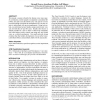Free Online Productivity Tools
i2Speak
i2Symbol
i2OCR
iTex2Img
iWeb2Print
iWeb2Shot
i2Type
iPdf2Split
iPdf2Merge
i2Bopomofo
i2Arabic
i2Style
i2Image
i2PDF
iLatex2Rtf
Sci2ools
CHI
2009
ACM
2009
ACM
The VoiceBot: a voice controlled robot arm
We present a system whereby the human voice may specify continuous control signals to manipulate a simulated 2D robotic arm and a real 3D robotic arm. Our goal is to move towards making accessible the manipulation of everyday objects to individuals with motor impairments. Using our system, we performed several studies using control style variants for both the 2D and 3D arms. Results show that it is indeed possible for a user to learn to effectively manipulate real-world objects with a robotic arm using only non-verbal voice as a control mechanism. Our results provide strong evidence that the further development of non-verbal voicecontrolled robotics and prosthetic limbs will be successful. Author Keywords Voice-based interface, speech recognition, motor impairment, robotics ACM Classification Keywords H.5.2 Information Interfaces and Presentation: User interfaces ?--Voice I/O; K.4.2 Computer and Society: Social Issues--Assistive technologies for persons with disabilities
CHI 2009 | Human Computer Interaction | Keywords Voice-based Interface | Non-verbal Voicecontrolled Robotics | Robotic Arm |
| Added | 24 Nov 2009 |
| Updated | 24 Nov 2009 |
| Type | Conference |
| Year | 2009 |
| Where | CHI |
| Authors | Brandi House, Jonathan Malkin, Jeff Bilmes |
Comments (0)

